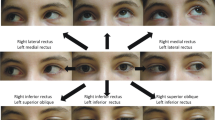Abstract
Objective
To demonstrate feasibility of near-real-time oculodynamic magnetic resonance imaging (od-MRI) in depicting extraocular muscles and correlate quantitatively the motion degree in comparison with clinical testing in patients with diplopia.
Methods
In 30 od-MRIs eye movements were tracked in the horizontal and sagittal plane using a a TrueFISP sequence with high temporal resolution. Three physicians graded the visibility of extraocular muscles by a qualitative scale. In 12 cases, the maximal monocular excursions in the horizontal and vertical direction of both eyes were measured in od-MRIs and a clinical test and correlated by the Pearson test.
Results
The medial and lateral rectus muscles were visible in the axial plane in 93% of the cases. The oblique, superior and inferior rectus muscles were overall only in 14% visible. Horizontal (p = 0,015) and vertical (p = 0,029) movements of the right eye and vertical movement of the left eye (p = 0,026) measured by od-MRI correlated positively to the clinical measurements.
Conclusions
Od-MRI is a feasible technique. Visualization of the horizontal/vertical rectus muscles is better than for the superior/inferior oblique muscle. Od-MRI correlates well with clinical testing and may reproduce the extent of eye bulb motility and extraocular muscle structural or functional deteriorations.
Key Points
• Oculodynamic MRI technique helps clinicians to assess eye bulb motility disorders
• MRI evaluation of eye movement provides functional information in cases of diplopia
• Oculodynamic MRI reproduces excursion of extraocular muscles with good correlation with clinical testing
• Dynamic MRI sequence supplements static orbital protocol for evaluation of motility disorders





Similar content being viewed by others
References
Kono R, Clark RA, Demer JL (2002) Active pulleys: magnetic resonance imaging of rectus muscle paths in tertiary gazes. Invest Ophthalmol Vis Sci 43:2179–2188
Palmowski-Wolfe AM, Kober C, Berg I, Kunz C, Wetzel S, Buitrago-Téllez C, Radü EW, Scheffler K (2009) Globe restriction in a severely myopic patient visualized through oculodynamic magnetic resonance imaging (od-MRI). J AAPOS 13:322–4
Palmowski-Wolfe AM, Berg I, Wetzel S, Kunz C, Radü EW, Scheffler K, Buitrago-Téllez C, Kober C (2010) Bilateral VI nerve injury. Ophthalmology 117:398.e1-2
Abolmaali ND, Schmitt J, Schwarz W, Toll DE, Hinterwimmer S, Vogl TJ (2004) Visualization of the articular disk of the temporomandibular joint in near-real-time MRI: feasability study. Eur Radiol 14:1889–94
Rüssmann W (2003) Basic methods of strabismology. Ophthalmologe 100:416–30, quiz 431-2
Bailey CC, Kabala J, Laitt R, Weston M, Goddard P, Hoh HB, Potts MJ, Harrad RA (1993) Cine magnetic resonance imaging of eye movements. Eye (Lond) 7(Pt 5):691–693
Shin GS, Demer JL, Rosenbaum AL (1996) High resolution, dynamic, magnetic resonance imaging in complicated strabismus. J Pediatr Ophthalmol Strabismus 33:282–90
Speeg-Schatz C (2002) MRI used in the exploration of occulomotor muscles. J Fr Ophtalmol 25:956–8
Eter N, Garbe S, Pauleit D, Schüttoff T, Schüller H (2003) Magnetic resonance imaging analysis of anterior and posterior eye segment displacement during ocular gaze shifts. Eur J Ophthalmol 13:196–201
Krzizoh TH, Kaufmann H, Traupe H (1997) Elucidation of restrictive motility in high myopia by magnetic resonance imaging. Arch Ophthalmol 115:1019–27
Katzberg RW, Bessette RW, Tallents RH, Plewes DB, Manzione JV, Schenck JF, Foster TH, Hart HR (1986) Normal and abnormal temporomandibular joint: MR imaging with surface coil. Radiology 158:183–189
Burnett KR, Davis CL, Read J (1987) Dynamic display of the temporomandibular joint meniscus by using “fastscan” MR imaging. Am J Roentgenol 149:959–962
Barkhausen J, Goyen M, von Winterfeld F, Lauenstein T, Arweiler-Harbeck D, Debatin JF (2002) Visualization of swallowing using real-time TrueFISP MR fluoroscopy. Eur Radiol 12:129–33
Hayakawa Y, Kober C, Otonari-Yamamoto M, Otonari T, Wakoh M, Sano T (2007) An approach for three-dimensional visualization using high-resolution MRI of the temporomandibular joint. Dentomaxillofac Radiol 36:341–347
Kakizaki H, Selva D, Leibovitch I (2010) Dynamic study of the medial and lateral recti capsulopalpebral fasciae using cine mode magnetic resonance imaging. Ophthalmology 117:388–91
Kau HC, Tsai CC, Ortube MC, Demer JL (2007) High-resolution magnetic resonance imaging of the extraocular muscles and nerves demonstrates various etiologies of third nerve palsy. Am J Ophthalmol 143:280–287
Piccirelli M, Luechinger R, Rutz AK et al (2007) Extraocular muscle deformation assessed by motion-encoded MRI during eye movement in healthy subjects. J Vis 7:5.1–10
Demer JL, Ortube MC, Engle EC, Thacker N (2006) High-resolution magnetic resonance imaging demonstrates abnormalities of motor nerves and extraocular muscles in patients with neuropathic strabismus. J AAPOS 10:135–42
Acknowledgements
Christoph Kunz and Carlos Buitrago-Tellez contributed equally to this work. Special thanks to the MRI radiological technician team of the Department of Radiology of the University of Basel, Switzerland for valuable support for image acquisition
Author information
Authors and Affiliations
Corresponding author
Rights and permissions
About this article
Cite this article
Berg, I., Palmowski-Wolfe, A., Schwenzer-Zimmerer, K. et al. Near-real time oculodynamic MRI: a feasibility study for evaluation of diplopia in comparison with clinical testing. Eur Radiol 22, 358–363 (2012). https://doi.org/10.1007/s00330-011-2232-1
Received:
Accepted:
Published:
Issue Date:
DOI: https://doi.org/10.1007/s00330-011-2232-1




